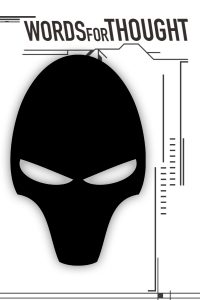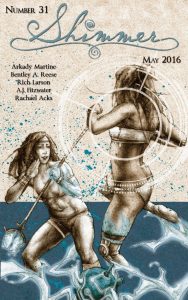
Welcome back to Words for Thought. The following five stories all deal with loss and memory, each looking at it from a different angle and each resulting in a powerful tale.
“Life in Stone, Glass, and Plastic” by José Pablo Iriarte from Strange Horizons' June issue tells the story of Sergio, who works as a jack-of-all-trades, fixing what needs fixing, including cleaning up graffiti. One day, he discovers a particularly interesting piece of graffiti — a mosaic that seemingly sprang up overnight, made of marbles and reading glasses and keys and other household items sunk right into the building's cement. When he touches the mosaic, Sergio is transported, seeing through the eyes of a little boy as his father is shot by the police. Traumatized by the experience, Sergio leaves the mosaic in place, going home to care for his wife, who has Alzheimer's. Due to his wife's condition, Sergio is particularly interested in memory — its loss, its limits, and its possibilities. Despite his fear, he seeks out other mosaics, all of which hold living memories, and all of which focus on sorrow and tragedy. He sets out to find the artist, determined to discover who is creating the mosaics and why they're all filled with pain. The interplay of art and magic in this story are lovely, but the quiet domestic scenes are what truly make the story outstanding. Sergio's pain at losing his wife is real, and his struggle to hold onto the good times as her memories slip away is bittersweet. The theme of memory that echoes throughout the story is a poignant one. Tragedy deserves to be memorialized, and when terrible acts are forgotten we risk repeating them. At the same time, what do we lose if painful moments are the only ones we hold onto? Iriarte delivers up a story that is melancholy in tone, but filled with hope as well.
“.subroutine:all///end” by Rachael Acks from Issue 31 of Shimmer also deals with memory loss due to Alzheimer's. Acks' story is told from the point of view of an AI Caregiver assigned to a woman named Helen. The AI wears the appearance of Anastasia, her charge's late wife, which causes tension with Helen's daughter Carrie. Anastasia was her mother's lover before she married, and then again after she divorced Carrie's father. Anastasia's is the face Helen finds most soothing, the one she remembers even when she can't recall her daughter's husband, or where she is, or that her daughter is a grown woman and not a college student. The story's structure lends power to the emotional content, alternating command lines for the AI's subroutines with the execution of those commands. While the AI repeatedly assures the reader it doesn't feel emotion, the subroutines it has built to care for Helen — singing her to sleep when she awakes frightened and disoriented, stroking her hair — suggest a genuine connection that goes beyond programming. Acks explores compassion and love in the story as concepts not limited to humanity, as well as exploring the impact emotion has on memory. The AI who claims to be emotionless has the truest picture of Helen, unclouded by bias, where Carrie brings baggage to the relationship and thus has a very different picture of her mother — one tinged with resentment and anger. If the AI's care subroutines are lost, will Helen be lost as well, or is Carrie's skewed memory of her mother enough? The story delivers a gut punch on multiple levels, and shows truly complex and nuanced relationships in a relatively short amount of time. Beneath the surface of the story lies the suggestion that Anastasia and Helen were always each other's true loves, but that social convention and expectation kept them from marrying until later in life. In this context, it's easy to understand Carrie feeling cut out of her mother's heart. If Helen only married Carrie's father for the sake of show, what does that mean for Carrie and her mother's relationship? This extends into the idea of memory as a burden. Helen doesn't remember her visits with Carrie, while Carrie does, along with all the hurt they bring - both past and present. “.subroutine:end///” all is a lovely story, rich, layered, and emotional, all while being economically told.
“Points of Reverie Aboard the Gen Ship” by T.D. Walker from the Summer Issue of Kaleidotrope tackles memory in a different way, not its loss, but its persistence as a source of pain. Told at roughly flash length, Avery moves through the generation ship that is her new home, with each point she passes evoking a memory of Earth and what has been left behind. Avery is a teacher aboard the ship as she was back home. Small moments demonstrate what has been lost, along with Avery's efforts to create a new life. The paper animals decorating her classroom on the ship remind her of things left behind, like her cat, so she makes new animals matching those onboard the ship — cows, hens, and sheep — practical animals that serve as a source of wool, eggs, milk, and meat. Avery's relationships in the present fall apart as she struggles to adjust, caught in the past, and seemingly ungrounded in her present reality. She is adrift emotionally, which Walker contrasts with the imagery of Avery physically anchoring herself through touch points. Even as she loses herself in the past, Avery grounds herself in the present by laying her hands on bits of the ship. Eventually, this becomes the story's ray of hope, suggesting Avery will eventually find her way into the now, and from there, find a way forward. She unwittingly gathers a following, others on the ship who are lost, but who use her touch points to ground themselves and begin building new memories and a new future.
“The One Who Isn't” by Ted Kosmatka from the July issue of Lightspeed opens with a child in a room who can't remember his name, or ever being outside the room. There's a woman with a face like a porcelain mask who comes every day to ask him questions and tell him stories. The first story she tells is about a queen who defies her husband and sends their child away to protect him from becoming cruel like his father. The king punishes her by forcing her into a cycle of perpetual immaculate conception: every three years she gives birth to a child, raises it for three years, and then the king kills it before her eyes while telling the child "This is because of your mother." The woman also tells a story of a sick boy in a hospital room who can never leave, and the story of a professor who had an affair with his student, had a child with her, and left his wife. The wife, who had always wanted a child of her own, stole a copy of the child and transferred him into an AI so she could keep for herself in her own virtual reality. All the stories feature parents, children, and death, but the last seems closest to the truth. The story ends as the woman watches the child die, the system reboot, and the child wake up a blank slate so she must start over again. Kosmatka blends science fiction, fairy tale, and horror. The loss of memory in this story is both a curse and a blessing. The child in the room lives in a state of perpetual innocence, but he has no sense of self or control over his world. At the same time, he doesn't remember his deaths or suffer from them. “The One Who Isn't” questions the nature of reality, plays with the idea of an AI infected with its creator's guilt, and the notion that the woman herself might be a virtual copy caught inside a story she's telling and retelling in search of a happy ending. The ambiguity built into the story points to the nature of memory itself. It is imperfect; memories are made by the stories we tell, building them into a narrative to help us make sense of the world.
“Postcards from Natalie” by Carrie Laben from the July issue of The Dark deals with keepsakes and the physicality of memory. Mandy's sister Natalie ran away from home with her boyfriend Keith, but she sends postcards home. One of the first postcards Mandy receives relates how Keith abandoned Natalie, and she woke up cold and alone under a tree. The postcards are a physical link to her sister, and Mandy clings to them even as she tries to find a way to go on with her life and build a new normal. Natalie later writes about joining up with others who are journeying across the country. Her group slowly grows, but every now and then, one of them disappears. There is a sense of unease threaded through the story, one that builds to the slow reveal of Natalie's fate. She never woke up under the tree; when Keith abandoned her, he was abandoning her body after she accidentally overdosed. The memory of Natalie is a physical thing, still able to interact with Mandy through the postcards. Laben works the idea of memory and sustaining hope into the mechanics of her ghosts in the story. Once a person's remains are identified, their ghosts vanish. However, as long as they remain unidentified, then hope is still alive, as are they, in a way. Like Iriarte's story, Laben shows the good and bad sides of memory, the pain it can bring, but the hope as well. Mandy's relationship with both her sister and her mother are one of this story's strengths, as is the way it slowly builds to its reveal, making for an emotionally satisfying ending, rather than a cheap twist.













